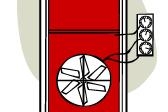
Part of establishing how well your home fares in terms of passive design is to establish how ‘tight’ it is. Learn more about how to test how much air leaks from your home.

If you are looking to plan a new ventilation system, upgrade an old one, or if you’re not getting the results you should be from your existing system, you should think carefully about the effects of infiltration. Modern buildings are built to be air tight – controlling how much air can flow in and out does a lot to improve energy efficiency. Infiltrating air, while good for your health, is quite problematic when it comes to controlling heating, cooling and ventilation. In the past, measuring for air tightness was rare; it wasn’t something that was of great concern to most builders.
The blower door
You could figure out your home’s air tightness and infiltration rates mathematically, but it is a long, difficult process. Alternatively, you could do a ‘blower door’ test. A blower door test involves sealing a powerful fan into an exterior doorway, which is then switched on. The blower door pressurises the home, forcing air through any cracks or gaps in the home’s facade, allowing you (or your builder) to find where they are. You can also measure the air pressure in the home, to see how much it retains. Ultimately, the goal is to achieve good air pressure and air tightness in the home with little effort from the fan.
Build tight and ventilate
Relying on infiltration to provide you with enough ventilation is a recipe for disaster. There is no way to judge how effective it will be, or to ensure it has consistency, and a careless approach to air tightness can make a huge difference to how well you’re able to heat and cool your home. Your best bet for energy efficiency and proper ventilation is to build your home air tight, then use a combination of active and passive ventilation methods with the aim of achieving two to three air changes per hour.





